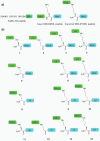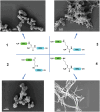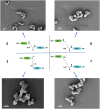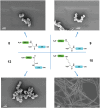Understanding Self-Assembly of Silica-Precipitating Peptides to Control Silica Particle Morphology
- PMID: 36509953
- PMCID: PMC11475327
- DOI: 10.1002/adma.202207586
Understanding Self-Assembly of Silica-Precipitating Peptides to Control Silica Particle Morphology
Abstract
The most advanced materials are those found in nature. These evolutionary optimized substances provide highest efficiencies, e.g., in harvesting solar energy or providing extreme stability, and are intrinsically biocompatible. However, the mimicry of biological materials is limited to a few successful applications since there is still a lack of the tools to recreate natural materials. Herein, such means are provided based on a peptide library derived from the silaffin protein R5 that enables rational biomimetic materials design. It is now evident that biomaterials do not form via mechanisms observed in vitro. Instead, the material's function and morphology are predetermined by precursors that self-assemble in solution, often from a combination of protein and salts. These assemblies act as templates for biomaterials. The RRIL peptides used here are a small part of the silica-precipitation machinery in diatoms. By connecting RRIL motifs via varying central bi- or trifunctional residues, a library of stereoisomers is generated, which allows characterization of different template structures in the presence of phosphate ions by combining residue-resolved real-time NMR spectroscopy and molecular dynamics (MD) simulations. Understanding these templates in atomistic detail, the morphology of silica particles is controlled via manipulation of the template precursors.
Keywords: biomineralization; molecular dynamics; peptide self-assembly; silica particles; silica precipitation.
© 2023 The Authors. Advanced Materials published by Wiley-VCH GmbH.
Conflict of interest statement
The authors declare no conflict of interest.
Figures







Similar articles
-
An Atomistic View on the Mechanism of Diatom Peptide-Guided Biomimetic Silica Formation.Adv Sci (Weinh). 2024 Aug;11(30):e2401239. doi: 10.1002/advs.202401239. Epub 2024 Jun 14. Adv Sci (Weinh). 2024. PMID: 38874418 Free PMC article.
-
A sequence-function analysis of the silica precipitating silaffin R5 peptide.J Pept Sci. 2014 Feb;20(2):152-8. doi: 10.1002/psc.2577. J Pept Sci. 2014. PMID: 25975421
-
Peptides from diatoms and grasses harness phosphate ion binding to silica to help regulate biomaterial structure.Acta Biomater. 2020 Aug;112:286-297. doi: 10.1016/j.actbio.2020.05.006. Epub 2020 May 17. Acta Biomater. 2020. PMID: 32434074
-
Peptides for Silica Precipitation: Amino Acid Sequences for Directing Mineralization.Protein Pept Lett. 2018;25(1):15-24. doi: 10.2174/0929866525666171214111007. Protein Pept Lett. 2018. PMID: 29237367 Review.
-
Silaffins in Silica Biomineralization and Biomimetic Silica Precipitation.Mar Drugs. 2015 Aug 19;13(8):5297-333. doi: 10.3390/md13085297. Mar Drugs. 2015. PMID: 26295401 Free PMC article. Review.
Cited by
-
The structure of His15 acetamide-modified hen egg-white lysozyme: a nice surprise from an old friend.Acta Crystallogr F Struct Biol Commun. 2025 Feb 1;81(Pt 2):41-46. doi: 10.1107/S2053230X2500010X. Epub 2025 Jan 13. Acta Crystallogr F Struct Biol Commun. 2025. PMID: 39804568 Free PMC article.
-
R5 Peptides Constitute Condensed Phases with Liquid-Like Properties in Biomimetic Silica Capsules.J Phys Chem Lett. 2025 May 1;16(17):4326-4335. doi: 10.1021/acs.jpclett.5c00144. Epub 2025 Apr 23. J Phys Chem Lett. 2025. PMID: 40267258 Free PMC article.
-
Exploiting Silica-Binding and Silica-Forming Proteins as Versatile Tools for One-Step Enzyme Immobilization on Siliceous Materials.Int J Mol Sci. 2025 Feb 3;26(3):1304. doi: 10.3390/ijms26031304. Int J Mol Sci. 2025. PMID: 39941072 Free PMC article. Review.
-
Biphasic NMR of Hyperpolarized Suspensions-Real-Time Monitoring of Solute-to-Solid Conversion to Watch Materials Grow.J Phys Chem C Nanomater Interfaces. 2023 Sep 21;127(39):19591-19598. doi: 10.1021/acs.jpcc.3c04198. eCollection 2023 Oct 5. J Phys Chem C Nanomater Interfaces. 2023. PMID: 37817917 Free PMC article.
-
Formation of Hybrid Spherical Silica Particles Using a Novel Alkoxy-Functional Polysilsesquioxane Macromonomer as a Precursor in an Acid-Catalyzed Sol-Gel Process.Materials (Basel). 2025 Jul 17;18(14):3357. doi: 10.3390/ma18143357. Materials (Basel). 2025. PMID: 40731568 Free PMC article.
References
-
- Whitesides G. M., Grzybowski B., Science 2002, 295, 2418. - PubMed
-
- Levin A., Hakala T. A., Schnaider L., Bernardes G. J. L., Gazit E., Knowles T. P. J., Nat. Rev. Chem. 2020, 4, 615.
-
- Zelzer M., Ulijn R. V., Chem. Soc. Rev. 2010, 39, 3351. - PubMed
-
- Choi S.‐J., Jeong W.‐J., Kang S.‐K., Lee M., Kim E., Ryu D. Y., Lim Y.‐B., Biomacromolecules 2012, 13, 1991. - PubMed
MeSH terms
Substances
Grants and funding
LinkOut - more resources
Full Text Sources

